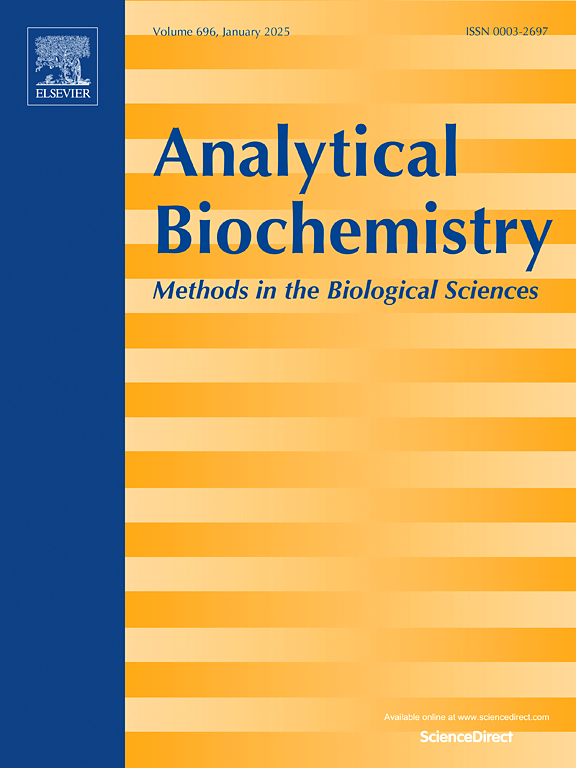使用微生物谷氨酰胺转胺酶的生物素结合蛋白的简单叠氮标记:实用笔记。
IF 2.5
4区 生物学
Q2 BIOCHEMICAL RESEARCH METHODS
引用次数: 0
摘要
微生物转谷氨酰胺酶(MTG)是一种Ca2+独立的酶,可以在温和的条件下进行位点特异性蛋白标记。然而,底物结构和蛋白质特异性环境如何影响MTG反应性尚不完全清楚。在这项研究中,我们合成了一种新的基于谷氨酰胺的叠氮化物供体(化合物1),并将其与市购的基于胺的叠氮化物受体(3-叠氮化物-1-丙胺)一起使用,以评估mtg介导的五种生物素结合蛋白的标记:亲和素、链亲和素、中性亲和素、Tamavidin 2和Tamavidin 2- lpi。采用菌株促进叠氮化物-炔环加成法(spac)与DBCO-Cy5对叠氮化物修饰蛋白进行可视化,并通过比较MTG+和MTG-条件来评估标记效率。Tamavidin 2对这两种底物都有很高的反应性,而Tamavidin 2- lpi几乎没有标记。链亲和素仅被胺基底物标记,而亲和素和中性亲和素主要被谷氨酰胺基底物标记。值得注意的是,NeutrAvidin在没有MTG的情况下也显示出很强的荧光,表明它们之间存在非特异性相互作用。这些结果表明,mtg介导的标记受底物相容性和蛋白质依赖因素的控制。虽然确切的修饰位点仍未确定,但本研究为使用MTG和互补叠氮化物试剂选择性结合生物素-蛋白质提供了一个实用的框架。本文章由计算机程序翻译,如有差异,请以英文原文为准。

Simple azide labeling of biotin-binding proteins using microbial transglutaminase: A practical note
Microbial transglutaminase (MTG) is a Ca2+-independent enzyme that enables site-specific protein labeling under mild conditions. However, how substrate structure and protein-specific environments influence MTG reactivity is not yet fully understood. In this study, we synthesized a novel glutamine-based azide donor (compound 1) and used it alongside a commercially available amine-based azide acceptor (3-azido-1-propylamine) to evaluate MTG-mediated labeling of five biotin-binding proteins: Avidin, Streptavidin, NeutrAvidin, Tamavidin 2, and Tamavidin 2-LPI. Azide-modified proteins were visualized using strain-promoted azide–alkyne cycloaddition (SPAAC) with DBCO-Cy5, and labeling efficiency was assessed by comparing MTG+ and MTG− conditions. Tamavidin 2 showed high reactivity toward both substrates, while Tamavidin 2-LPI exhibited little to no labeling. Streptavidin was labeled only by the amine-based substrate, whereas Avidin and NeutrAvidin were mainly labeled by the glutamine-based substrate. Notably, NeutrAvidin also showed strong fluorescence in the absence of MTG, suggesting non-specific interaction. These results indicate that MTG-mediated labeling is governed by both substrate compatibility and protein-dependent factors. Although the exact modification sites remain unidentified, this study provides a practical framework for selective biotin-protein conjugation using MTG and complementary azide reagents.
求助全文
通过发布文献求助,成功后即可免费获取论文全文。
去求助
来源期刊

Analytical biochemistry
生物-分析化学
CiteScore
5.70
自引率
0.00%
发文量
283
审稿时长
44 days
期刊介绍:
The journal''s title Analytical Biochemistry: Methods in the Biological Sciences declares its broad scope: methods for the basic biological sciences that include biochemistry, molecular genetics, cell biology, proteomics, immunology, bioinformatics and wherever the frontiers of research take the field.
The emphasis is on methods from the strictly analytical to the more preparative that would include novel approaches to protein purification as well as improvements in cell and organ culture. The actual techniques are equally inclusive ranging from aptamers to zymology.
The journal has been particularly active in:
-Analytical techniques for biological molecules-
Aptamer selection and utilization-
Biosensors-
Chromatography-
Cloning, sequencing and mutagenesis-
Electrochemical methods-
Electrophoresis-
Enzyme characterization methods-
Immunological approaches-
Mass spectrometry of proteins and nucleic acids-
Metabolomics-
Nano level techniques-
Optical spectroscopy in all its forms.
The journal is reluctant to include most drug and strictly clinical studies as there are more suitable publication platforms for these types of papers.
 求助内容:
求助内容: 应助结果提醒方式:
应助结果提醒方式:


